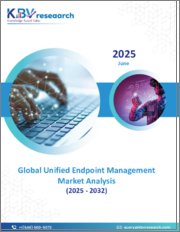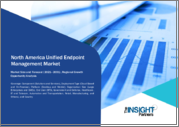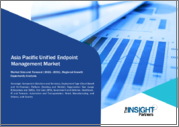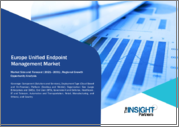
|
시장보고서
상품코드
1598767
통합 엔드포인트 관리 시장 : 구성요소별, 조직별, 산업별 - 세계 예측(2025-2030년)Unified Endpoint Management Market by Component (Services, Solutions), Organization (Large Enterprises, SMEs), Vertical - Global Forecast 2025-2030 |
||||||
통합 엔드포인트 관리 시장의 2023년 시장 규모는 51억 5,000만 달러로 2024년에는 62억 달러에 달할 것으로 예상되며, 연평균 20.70% 성장하여 2030년에는 192억 4,000만 달러에 달할 것으로 예상됩니다.
통합 엔드포인트 관리(UEM)는 스마트폰, 태블릿, 노트북, 데스크톱 등 다양한 엔드포인트를 하나의 콘솔에서 관리하고 보호할 수 있도록 설계된 종합적인 솔루션입니다. UEM은 모바일 디바이스 관리(MDM)와 기업 모빌리티 관리(EMM)의 원활한 통합을 촉진하여 보안을 강화하고, 운영을 간소화하며, 사용자 경험을 개선하는 데 도움을 줍니다. UEM은 헬스케어, IT 및 통신, 리테일, 금융 서비스 등의 산업에서 적용되고 있으며, 방대한 양의 데이터와 디바이스를 효율적으로 처리할 수 있는 강력한 관리 툴을 제공하고 있습니다. 원격 문제 해결, 애플리케이션 배포, 보안 정책 시행 등의 기능을 통해 여러 운영체제에 걸쳐 안전한 디바이스 관리를 원하는 기업까지 최종 사용 범위가 확대되고 있습니다.
| 주요 시장 통계 | |
|---|---|
| 기준 연도[2023] | 51억 5,000만 달러 |
| 예측 연도[2024] | 62억 달러 |
| 예측 연도[2030] | 192억 4,000만 달러 |
| CAGR(%) | 20.70% |
시장 인사이트에 따르면, UEM 시장의 성장은 BYOD(Bring Your Own Device) 전략의 채택 증가, 보안에 대한 우려 증가, 규제 준수에 대한 필요성에 의해 주도되고 있습니다. 최근 위협 탐지 및 대응 능력을 향상시킬 수 있는 AI와 머신러닝의 발전은 비즈니스 기회로 작용하고 있습니다. 조직은 잠재적인 위협과 비효율성에 선제적으로 대응하기 위해 UEM 시스템 내 예측 분석에 투자하는 것이 권장되고 있습니다. 그러나 높은 초기 도입 비용, 기존 시스템과의 통합의 복잡성, 적절히 관리되지 않을 경우 잠재적인 보안 취약성 등의 문제가 큰 제약 요인으로 작용하고 있습니다.
UEM 프레임워크 내 제로 트러스트 보안 모델 개발, AI 기반 분석의 고도화 및 통합 등 혁신 분야는 성장 가능성이 높은 분야입니다. IoT 기기와의 원활한 통합과 보다 스마트한 자동화 프로세스 구현에 초점을 맞춘 연구는 경쟁 우위를 가져다 줄 수 있습니다. UEM 시장의 특성은 매우 역동적이며, 새로운 위협과 기술 발전에 대한 지속적인 적응을 요구합니다. 혁신적이고 진화하는 엔드유저의 수요에 대응할 수 있는 기업들은 이 성장하는 시장에서 자본을 확보할 수 있는 기회를 얻을 수 있습니다.
시장 역학 : 빠르게 진화하는 통합 엔드포인트 관리 시장의 주요 시장 인사이트 공개
통합 엔드포인트 관리 시장은 수요와 공급의 역동적인 상호작용으로 인해 변화하고 있습니다. 이러한 시장 역학의 변화를 이해함으로써 기업은 정보에 입각한 투자 결정을 내리고, 전략적 의사결정을 정교화하며, 새로운 비즈니스 기회를 포착할 수 있습니다. 이러한 트렌드를 종합적으로 파악함으로써 기업은 정치적, 지리적, 기술적, 사회적, 경제적 영역 전반에 걸친 다양한 리스크를 줄일 수 있으며, 소비자 행동과 그것이 제조 비용 및 구매 동향에 미치는 영향을 보다 명확하게 이해할 수 있습니다.
- 시장 촉진요인
- 인터넷과 스마트폰의 보급 확대
- 조직의 자동화 발전
- 디지털화를 위한 정부의 노력과 투자
- 시장 억제요인
- 높은 통합 엔드포인트 관리 비용
- 시장 기회
- 통합 엔드포인트 관리의 기술적 발전
- 기업의 클라우드 및 커넥티드 디바이스 채택 확대
- 시장 과제
- 보안 및 데이터 프라이버시 관련 문제
Porter's Five Forces : 통합 엔드포인트 관리 시장 공략을 위한 전략적 도구
"Porter's Five Forces" 프레임워크는 시장 상황의 경쟁 상황을 파악하는 중요한 도구입니다. Porter's Five Forces 프레임워크는 기업의 경쟁력을 평가하고 전략적 기회를 탐색할 수 있는 명확한 방법을 제공합니다. 이 프레임워크는 기업이 시장 내 세력도를 평가하고 신규 사업의 수익성을 판단하는 데 도움이 됩니다. 이러한 인사이트를 통해 기업은 강점을 활용하고, 약점을 해결하고, 잠재적인 도전을 피하고, 보다 강력한 시장 포지셔닝을 확보할 수 있습니다.
PESTLE 분석 : 통합 엔드포인트 관리 시장의 외부 영향 파악
외부 거시 환경 요인은 통합 엔드포인트 관리 시장의 성과 역학을 형성하는 데 매우 중요한 역할을 합니다. 정치적, 경제적, 사회적, 기술적, 법적, 환경적 요인에 대한 분석은 이러한 영향을 탐색하는 데 필요한 정보를 제공하며, PESTLE 요인을 조사함으로써 기업은 잠재적인 위험과 기회를 더 잘 이해할 수 있습니다. 이러한 분석을 통해 기업은 규제, 소비자 선호도, 경제 동향의 변화를 예측하고 선제적이고 능동적인 의사결정을 내릴 준비를 할 수 있습니다.
시장 점유율 분석 : 통합 엔드포인트 관리 시장에서의 경쟁 상황 파악
통합 엔드포인트 관리 시장의 상세한 시장 점유율 분석을 통해 벤더의 성과를 종합적으로 평가할 수 있습니다. 기업은 수익, 고객 기반, 성장률과 같은 주요 지표를 비교하여 경쟁적 위치를 파악할 수 있습니다. 이 분석은 시장의 집중화, 단편화, 통합의 추세를 파악할 수 있으며, 공급업체는 치열한 경쟁 속에서 자신의 입지를 강화할 수 있는 전략적 의사결정을 내리는 데 필요한 인사이트를 얻을 수 있습니다.
FPNV 포지셔닝 매트릭스 : 통합 엔드포인트 관리 시장에서의 벤더 성과 평가
FPNV 포지셔닝 매트릭스는 통합 엔드포인트 관리 시장에서 벤더를 평가할 수 있는 중요한 도구입니다. 이 매트릭스를 통해 기업은 벤더의 비즈니스 전략과 제품 만족도를 기반으로 벤더를 평가하여 목표에 부합하는 정보에 입각한 의사결정을 내릴 수 있으며, 4개의 사분면으로 벤더를 명확하고 정확하게 세분화하여 전략 목표에 가장 적합한 파트너와 솔루션을 식별할 수 있습니다. 전략 목표에 가장 적합한 파트너와 솔루션을 식별할 수 있습니다.
통합 엔드포인트 관리 시장에서 성공하기 위한 전략 분석 및 추천 통합 엔드포인트 관리 시장에서의 성공 경로를 제시합니다.
통합 엔드포인트 관리 시장 전략 분석은 세계 시장에서 입지를 강화하고자 하는 기업에게 필수적입니다. 주요 자원, 역량 및 성과 지표를 검토함으로써 기업은 성장 기회를 파악하고 개선할 수 있습니다. 이러한 접근 방식을 통해 기업은 경쟁 환경의 도전을 극복하고 새로운 비즈니스 기회를 활용하여 장기적인 성공을 거둘 수 있도록 준비할 수 있습니다.
이 보고서는 주요 관심 분야를 포괄하는 시장에 대한 종합적인 분석을 제공합니다.
1. 시장 침투도 : 현재 시장 환경의 상세한 검토, 주요 기업의 광범위한 데이터, 시장 도달 범위 및 전반적인 영향력 평가.
2. 시장 개척도 : 신흥 시장에서의 성장 기회를 파악하고, 기존 분야의 확장 가능성을 평가하며, 미래 성장을 위한 전략적 로드맵을 제공합니다.
3. 시장 다각화 : 최근 제품 출시, 미개척 지역, 업계의 주요 발전, 시장을 형성하는 전략적 투자를 분석합니다.
4. 경쟁 평가 및 정보 : 경쟁 상황을 철저히 분석하여 시장 점유율, 사업 전략, 제품 포트폴리오, 인증, 규제 당국의 승인, 특허 동향, 주요 기업의 기술 발전 등을 검토합니다.
5. 제품 개발 및 혁신 : 향후 시장 성장을 촉진할 것으로 예상되는 첨단 기술, 연구 개발 활동 및 제품 혁신을 강조합니다.
이해관계자들이 충분한 정보를 바탕으로 의사결정을 내릴 수 있도록 다음과 같은 중요한 질문에 대한 답변도 제공합니다.
1. 현재 시장 규모와 향후 성장 전망은?
2. 최고의 투자 기회를 제공하는 제품, 부문, 지역은 어디인가?
3. 시장을 형성하는 주요 기술 동향과 규제의 영향은?
4. 주요 벤더의 시장 점유율과 경쟁 포지션은?
5. 벤더의 시장 진입 및 철수 전략의 원동력이 되는 수익원과 전략적 기회는 무엇인가?
목차
제1장 서문
제2장 조사 방법
제3장 주요 요약
제4장 시장 개요
제5장 시장 인사이트
- 시장 역학
- 성장 촉진요인
- 성장 억제요인
- 기회
- 과제
- 시장 세분화 분석
- Porter's Five Forces 분석
- PESTEL 분석
- 정치
- 경제
- 사회
- 기술
- 법률
- 환경
제6장 통합 엔드포인트 관리 시장 : 구성요소별
- 서비스
- 솔루션
제7장 통합 엔드포인트 관리 시장 조직별
- 대기업
- 중소기업
제8장 통합 엔드포인트 관리 시장 : 업계별
- BFSI
- 정부/방위
- 헬스케어
- 제조업
- 미디어와 엔터테인먼트
- 소매
- 통신·IT
제9장 아메리카의 통합 엔드포인트 관리 시장
- 아르헨티나
- 브라질
- 캐나다
- 멕시코
- 미국
제10장 아시아태평양의 통합 엔드포인트 관리 시장
- 호주
- 중국
- 인도
- 인도네시아
- 일본
- 말레이시아
- 필리핀
- 싱가포르
- 한국
- 대만
- 태국
- 베트남
제11장 유럽, 중동 및 아프리카의 통합 엔드포인트 관리 시장
- 덴마크
- 이집트
- 핀란드
- 프랑스
- 독일
- 이스라엘
- 이탈리아
- 네덜란드
- 나이지리아
- 노르웨이
- 폴란드
- 카타르
- 러시아
- 사우디아라비아
- 남아프리카공화국
- 스페인
- 스웨덴
- 스위스
- 터키
- 아랍에미리트
- 영국
제12장 경쟁 상황
- 시장 점유율 분석 2023
- FPNV 포지셔닝 매트릭스, 2023
- 경쟁 시나리오 분석
- 전략 분석과 제안
기업 리스트
- 42Gears Mobility Systems Pvt Ltd.
- BlackBerry Ltd.
- Broadcom Inc.
- Cisco Systems Inc.
- Citrix Systems Inc.
- Dell Inc.
- International Business Machines Corporation
- Ivanti Inc.
- Jamf Software LLC
- Matrix42 AG
- Microsoft Corporation
- Miradore Oy
- Mitsogo Inc.
- Snow Software AB
- Syxsense Inc.
The Unified Endpoint Management Market was valued at USD 5.15 billion in 2023, expected to reach USD 6.20 billion in 2024, and is projected to grow at a CAGR of 20.70%, to USD 19.24 billion by 2030.
Unified Endpoint Management (UEM) is a comprehensive solution designed to manage and secure various endpoints such as smartphones, tablets, laptops, and desktops from a single console. It facilitates seamless integration of mobile device management (MDM) and enterprise mobility management (EMM), thereby offering enhanced security, streamlined operations, and improved user experience. The necessity of UEM arises from the increasing complexity of digital workplaces, where a plethora of devices and platforms require consistent policies and controls. UEM is applied in industries such as healthcare, IT and telecom, retail, and financial services, providing these sectors with robust management tools to handle vast amounts of data and devices efficiently. The end-use scope expands to businesses looking to ensure secure device management across multiple operating systems with features like remote troubleshooting, application deployment, and security policy enforcement.
| KEY MARKET STATISTICS | |
|---|---|
| Base Year [2023] | USD 5.15 billion |
| Estimated Year [2024] | USD 6.20 billion |
| Forecast Year [2030] | USD 19.24 billion |
| CAGR (%) | 20.70% |
Market insights reveal that the growth of the UEM market is propelled by the rising adoption of BYOD (Bring Your Own Device) strategies, increased security concerns, and the need for regulatory compliance. Recent opportunities include advancements in AI and machine learning, which can enhance threat detection and response capabilities. Organizations are encouraged to invest in predictive analytics within UEM systems to proactively address potential threats and inefficiencies. However, challenges such as high initial implementation costs, complexity in integration with existing systems, and potential security vulnerabilities if not properly managed, are significant limiting factors.
Innovative areas that promise growth involve the development of zero-trust security models within UEM frameworks and the incorporation of advanced AI-driven analytics. Research focusing on seamless integration with IoT devices and enabling smarter automation processes can provide competitive advantages. The nature of the UEM market is highly dynamic, requiring continual adaptation to emerging threats and technological advancements. Companies positioned to innovate and address evolving end-user demands will potentially capitalize on this expanding market.
Market Dynamics: Unveiling Key Market Insights in the Rapidly Evolving Unified Endpoint Management Market
The Unified Endpoint Management Market is undergoing transformative changes driven by a dynamic interplay of supply and demand factors. Understanding these evolving market dynamics prepares business organizations to make informed investment decisions, refine strategic decisions, and seize new opportunities. By gaining a comprehensive view of these trends, business organizations can mitigate various risks across political, geographic, technical, social, and economic domains while also gaining a clearer understanding of consumer behavior and its impact on manufacturing costs and purchasing trends.
- Market Drivers
- Growing internet and smartphone penetration
- Rising automation in organizations
- Government initiatives and investments for digitization
- Market Restraints
- High cost of the unified endpoint management
- Market Opportunities
- Technological advancements in unified endpoint management
- Expanding cloud and connected devices adoption in businesses
- Market Challenges
- Security and data privacy concerns
Porter's Five Forces: A Strategic Tool for Navigating the Unified Endpoint Management Market
Porter's five forces framework is a critical tool for understanding the competitive landscape of the Unified Endpoint Management Market. It offers business organizations with a clear methodology for evaluating their competitive positioning and exploring strategic opportunities. This framework helps businesses assess the power dynamics within the market and determine the profitability of new ventures. With these insights, business organizations can leverage their strengths, address weaknesses, and avoid potential challenges, ensuring a more resilient market positioning.
PESTLE Analysis: Navigating External Influences in the Unified Endpoint Management Market
External macro-environmental factors play a pivotal role in shaping the performance dynamics of the Unified Endpoint Management Market. Political, Economic, Social, Technological, Legal, and Environmental factors analysis provides the necessary information to navigate these influences. By examining PESTLE factors, businesses can better understand potential risks and opportunities. This analysis enables business organizations to anticipate changes in regulations, consumer preferences, and economic trends, ensuring they are prepared to make proactive, forward-thinking decisions.
Market Share Analysis: Understanding the Competitive Landscape in the Unified Endpoint Management Market
A detailed market share analysis in the Unified Endpoint Management Market provides a comprehensive assessment of vendors' performance. Companies can identify their competitive positioning by comparing key metrics, including revenue, customer base, and growth rates. This analysis highlights market concentration, fragmentation, and trends in consolidation, offering vendors the insights required to make strategic decisions that enhance their position in an increasingly competitive landscape.
FPNV Positioning Matrix: Evaluating Vendors' Performance in the Unified Endpoint Management Market
The Forefront, Pathfinder, Niche, Vital (FPNV) Positioning Matrix is a critical tool for evaluating vendors within the Unified Endpoint Management Market. This matrix enables business organizations to make well-informed decisions that align with their goals by assessing vendors based on their business strategy and product satisfaction. The four quadrants provide a clear and precise segmentation of vendors, helping users identify the right partners and solutions that best fit their strategic objectives.
Strategy Analysis & Recommendation: Charting a Path to Success in the Unified Endpoint Management Market
A strategic analysis of the Unified Endpoint Management Market is essential for businesses looking to strengthen their global market presence. By reviewing key resources, capabilities, and performance indicators, business organizations can identify growth opportunities and work toward improvement. This approach helps businesses navigate challenges in the competitive landscape and ensures they are well-positioned to capitalize on newer opportunities and drive long-term success.
Key Company Profiles
The report delves into recent significant developments in the Unified Endpoint Management Market, highlighting leading vendors and their innovative profiles. These include 42Gears Mobility Systems Pvt Ltd., BlackBerry Ltd., Broadcom Inc., Cisco Systems Inc., Citrix Systems Inc., Dell Inc., International Business Machines Corporation, Ivanti Inc., Jamf Software LLC, Matrix42 AG, Microsoft Corporation, Miradore Oy, Mitsogo Inc., Snow Software AB, and Syxsense Inc..
Market Segmentation & Coverage
This research report categorizes the Unified Endpoint Management Market to forecast the revenues and analyze trends in each of the following sub-markets:
- Based on Component, market is studied across Services and Solutions.
- Based on Organization, market is studied across Large Enterprises and SMEs.
- Based on Vertical, market is studied across BFSI, Government/Defense, Healthcare, Manufacturing, Media & Entertainment, Retail, and Telecom & IT.
- Based on Region, market is studied across Americas, Asia-Pacific, and Europe, Middle East & Africa. The Americas is further studied across Argentina, Brazil, Canada, Mexico, and United States. The United States is further studied across California, Florida, Illinois, New York, Ohio, Pennsylvania, and Texas. The Asia-Pacific is further studied across Australia, China, India, Indonesia, Japan, Malaysia, Philippines, Singapore, South Korea, Taiwan, Thailand, and Vietnam. The Europe, Middle East & Africa is further studied across Denmark, Egypt, Finland, France, Germany, Israel, Italy, Netherlands, Nigeria, Norway, Poland, Qatar, Russia, Saudi Arabia, South Africa, Spain, Sweden, Switzerland, Turkey, United Arab Emirates, and United Kingdom.
The report offers a comprehensive analysis of the market, covering key focus areas:
1. Market Penetration: A detailed review of the current market environment, including extensive data from top industry players, evaluating their market reach and overall influence.
2. Market Development: Identifies growth opportunities in emerging markets and assesses expansion potential in established sectors, providing a strategic roadmap for future growth.
3. Market Diversification: Analyzes recent product launches, untapped geographic regions, major industry advancements, and strategic investments reshaping the market.
4. Competitive Assessment & Intelligence: Provides a thorough analysis of the competitive landscape, examining market share, business strategies, product portfolios, certifications, regulatory approvals, patent trends, and technological advancements of key players.
5. Product Development & Innovation: Highlights cutting-edge technologies, R&D activities, and product innovations expected to drive future market growth.
The report also answers critical questions to aid stakeholders in making informed decisions:
1. What is the current market size, and what is the forecasted growth?
2. Which products, segments, and regions offer the best investment opportunities?
3. What are the key technology trends and regulatory influences shaping the market?
4. How do leading vendors rank in terms of market share and competitive positioning?
5. What revenue sources and strategic opportunities drive vendors' market entry or exit strategies?
Table of Contents
1. Preface
- 1.1. Objectives of the Study
- 1.2. Market Segmentation & Coverage
- 1.3. Years Considered for the Study
- 1.4. Currency & Pricing
- 1.5. Language
- 1.6. Stakeholders
2. Research Methodology
- 2.1. Define: Research Objective
- 2.2. Determine: Research Design
- 2.3. Prepare: Research Instrument
- 2.4. Collect: Data Source
- 2.5. Analyze: Data Interpretation
- 2.6. Formulate: Data Verification
- 2.7. Publish: Research Report
- 2.8. Repeat: Report Update
3. Executive Summary
4. Market Overview
5. Market Insights
- 5.1. Market Dynamics
- 5.1.1. Drivers
- 5.1.1.1. Growing internet and smartphone penetration
- 5.1.1.2. Rising automation in organizations
- 5.1.1.3. Government initiatives and investments for digitization
- 5.1.2. Restraints
- 5.1.2.1. High cost of the unified endpoint management
- 5.1.3. Opportunities
- 5.1.3.1. Technological advancements in unified endpoint management
- 5.1.3.2. Expanding cloud and connected devices adoption in businesses
- 5.1.4. Challenges
- 5.1.4.1. Security and data privacy concerns
- 5.1.1. Drivers
- 5.2. Market Segmentation Analysis
- 5.3. Porter's Five Forces Analysis
- 5.3.1. Threat of New Entrants
- 5.3.2. Threat of Substitutes
- 5.3.3. Bargaining Power of Customers
- 5.3.4. Bargaining Power of Suppliers
- 5.3.5. Industry Rivalry
- 5.4. PESTLE Analysis
- 5.4.1. Political
- 5.4.2. Economic
- 5.4.3. Social
- 5.4.4. Technological
- 5.4.5. Legal
- 5.4.6. Environmental
6. Unified Endpoint Management Market, by Component
- 6.1. Introduction
- 6.2. Services
- 6.3. Solutions
7. Unified Endpoint Management Market, by Organization
- 7.1. Introduction
- 7.2. Large Enterprises
- 7.3. SMEs
8. Unified Endpoint Management Market, by Vertical
- 8.1. Introduction
- 8.2. BFSI
- 8.3. Government/Defense
- 8.4. Healthcare
- 8.5. Manufacturing
- 8.6. Media & Entertainment
- 8.7. Retail
- 8.8. Telecom & IT
9. Americas Unified Endpoint Management Market
- 9.1. Introduction
- 9.2. Argentina
- 9.3. Brazil
- 9.4. Canada
- 9.5. Mexico
- 9.6. United States
10. Asia-Pacific Unified Endpoint Management Market
- 10.1. Introduction
- 10.2. Australia
- 10.3. China
- 10.4. India
- 10.5. Indonesia
- 10.6. Japan
- 10.7. Malaysia
- 10.8. Philippines
- 10.9. Singapore
- 10.10. South Korea
- 10.11. Taiwan
- 10.12. Thailand
- 10.13. Vietnam
11. Europe, Middle East & Africa Unified Endpoint Management Market
- 11.1. Introduction
- 11.2. Denmark
- 11.3. Egypt
- 11.4. Finland
- 11.5. France
- 11.6. Germany
- 11.7. Israel
- 11.8. Italy
- 11.9. Netherlands
- 11.10. Nigeria
- 11.11. Norway
- 11.12. Poland
- 11.13. Qatar
- 11.14. Russia
- 11.15. Saudi Arabia
- 11.16. South Africa
- 11.17. Spain
- 11.18. Sweden
- 11.19. Switzerland
- 11.20. Turkey
- 11.21. United Arab Emirates
- 11.22. United Kingdom
12. Competitive Landscape
- 12.1. Market Share Analysis, 2023
- 12.2. FPNV Positioning Matrix, 2023
- 12.3. Competitive Scenario Analysis
- 12.4. Strategy Analysis & Recommendation
Companies Mentioned
- 1. 42Gears Mobility Systems Pvt Ltd.
- 2. BlackBerry Ltd.
- 3. Broadcom Inc.
- 4. Cisco Systems Inc.
- 5. Citrix Systems Inc.
- 6. Dell Inc.
- 7. International Business Machines Corporation
- 8. Ivanti Inc.
- 9. Jamf Software LLC
- 10. Matrix42 AG
- 11. Microsoft Corporation
- 12. Miradore Oy
- 13. Mitsogo Inc.
- 14. Snow Software AB
- 15. Syxsense Inc.



















